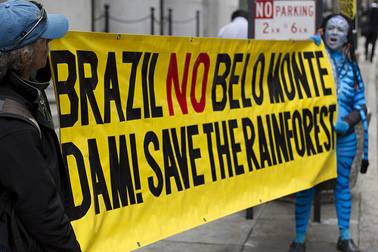
Formerly known as Kararaô, the Belo Monte Dam is a proposed hydroelectric dam complex on the Xingu River in the state of Pará, Brazil. The planned installed capacity of the dam complex is 11,233 megawatts (MW)
and this would make it world”s third-large
st dam in terms of installed capacity, (behind the Three Gorges Dam in China and the Brazilian-Paraguayan Itaipu Dam). The Belo Monte dam complex dates back to Brazil”s military dictatorship when the government attempted to build it through a series of national investment programs. Original plans to build a dam for Xingu did not come to fruition thanks to multiple public relations programs over a course of 20 years in the face of intense national and international protest. However, the Brazilian government wants to move ahead ‘at any cost’ to build this dam. Apparently, the environmental costs of Belo Monte Dam are not a main concern to the government when making this decision.
The Impacts of Belo Monte Dam on the Environment and the Inhabitants
To feed the powerhouse of the Belo Monte dam complex, up to 80 percent of the Xingu River will be diverted from its original course. This will cause a permanent drought on the river”s “Big Bend,” and directly affect the Paquiçamba and Arara territories of communities and tribes living in Juruna and Arara. The river will be diverted by excavating two huge canals that are 500 meters wide by 75 km long. This excavation will result in the unearthing of more land than what was removed to build the Panama Canal. The two reservoirs and canals of Belo Monte will flood a total of 668 square km. A big ecological concern is that 400 square km of this area is standing forest. Further, the flooding will force more than 20,000 people from their homes in the municipalities of Altamira and Vitoria do Xingu.
Supporters of Belo Monte cite the generation of hydro electric energy as the biggest advantage of this dam. They feel that it will be a solution to Brazil”s periodic blackouts and a ‘clean development’ approach to global climate change. However, a study by Philip Fearnside of the National Amazon Research Institute (INPA) has proved that the forests flooded by Belo Monte”s reservoirs will generate enormous quantities of methane, a greenhouse gas that is 25 times more harmful than carbon dioxide.
It has also been claimed that Belo Monte will attract 100,000 migrants to the region. But the fact is that even at the peak of construction work, hardly 40,000 jobs will be created and only 2,000 of these will be long term. Others may have to resort to illegal logging and cattle ranching which are already major environmental concerns and the causes of deforestation in the Amazon. Mega-projects also cause innumerable problems to local communities in terms of loss of food and clean water sources, diseases and cultural disintegration.
Long term impacts of Belo Monte are of even greater concern as industries such as aluminium and metal refineries, soy plantations, logging, and mining may expand into the area after the construction of the dam.
With such huge ‘costs’ to the people, animals and the environment, the construction of this hydro electric dam is indeed unreasonable and unjustified. Make your voice heard by signing petitions, joining protests, and asking others to join you in the fight against this environmental tragedy.

